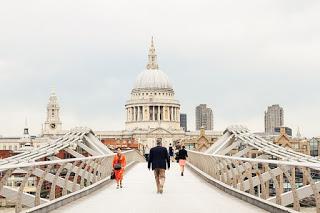
If you are looking for a different sort of vacation, if you are able to spend some time in England and you enjoy the sense of history that seems to ooze from the many old buildings there then consider doing a tour of some of the ancient cathedrals and abbeys that have stood for centuries in the towns and cities.
During the 12th and 13th centuries there was a great upsurge in the constuction of these remarkable, hugely detailed buildings; they still impress us today with their massive size and beauty so it is easy to imagine how awed medieval people would have been. It was thought then that simply visiting a holy place would impart holiness and so pilgrimage began. The pilgrims would travel from one holy shrine to another, often traveling in groups for safety and companionship. One such group, famous in literature, is the one depicted by Chaucer in his “Canterbury Tales” which shows us that the pilgrims were from all levels of society.
You could become a modern pilgrim, following a similar route to our ancient forebears, visiting the same great cathedrals though not on foot, perhaps, as they were. More than likely, the modern pilgrim will travel by car or as part of a tour group seeing a different town and cathedral each day.
Canterbury could be an appropriate cathedral to start your pilgrimage especially if, like Chaucer’s famous group, you set out from London, traveling south-east into the county of Kent, the lovely “Garden of England”. Canterbury is a magnificent cathedral whose history began as far back as 597AD with Saint Augustine. Its attraction as a pilgrimage destination grew after Archbishop Thomas Beckett was murdered in the cathedral in 1170 and it continues to attract thousands of pilgrims and visitors each year. This is the mother church of Anglicans and the sense of its history is inescapable as you tread on the massive flagstones and gaze up at the soaring arches. The visitor will devote many hours to the appreciation of the huge building both in and outside; here, as in all the medieval cathedrals, there are superb stained glass windows to admire.
In the heart of London is Westminster Abbey, the vision of King Edward the Confessor. It was consecrated in 1065 and since the crowning here of William the Conqueror in 1066 it has been traditional for royal coronations to take place here; the last coronation was that of Queen Elizabeth II in 1952. Over 1000 years of history can be traced through the tombs, the magnificent architecture is breathtaking; the sense of history as you touch the tombs of kings, queens and other great people from the past is humbling.
Also in London is Saint Paul’s cathedral, with its great dome that dominates the skyline. There has been a church on this site since 605, the first destroyed by fire, the second by Vikings in 962 and a third one again by fire, in 1087. Bad luck continued until Christopher Wren began restoration, but calamity struck again when The Great Fire of London in 1666 left the building a charred wreck. Wren then undertook the design and building of the magnificent building we admire today. Unlike the stark medieval cathedrals, Saint Paul’s is ornate, brilliantly white and gold and a dazzlingly beautiful monument to the 17th century.
In the county of Wiltshire, south-west of London you will find the city of Salisbury with its gothic cathedral built in the 13th century. This lovely cathedral is famed for having the tallest spire in England [404 ft] and inside the nave is strikingly high and narrow. The oldest working clock in Europe is here, dating from 1386. Also on display is a copy of Magna Carta, an important legal document in English history that was drawn up in 1215. It is one of only four existing copies and the best preserved, attracting thousands of visitors each year,
From Salisbury, the modern pilgrim could very easily proceed to Bath Abbey, in Somerset. The site was first used for a religious building in 675; centuries of successive building and destruction followed until Queen Elizabeth I ordered the restoration of the ancient abbey in 1574. It has strikingly beautiful fan vaulting and the interior of the abbey is unexpectedly light because of the unusual number of windows. In the huge east window, the life of Christ is depicted in 56 scenes. The local stone that the visitor may have observed in the lovely city of Bath was used in the construction of the abbey, a stone that seems to glow, especially in the evening light.
Bath abbey became neglected when bishops of previous centuries preferred Wells cathedral. This striking cathedral is also in Somerset, not far from Bath, so that the earlier pilgrims on foot would have easily moved from one to the other, to gain in holiness. The building of Wells cathedral was begun in 1180 and who could fail to be impressed by first sight of its West Front, where nearly 300 medieval life-size statues still stand in their niches in the façade. Wells is an architectural delight both in and outside; the modern pilgrim can easily spend a day just gazing in admiration at the astounding achievements of medieval craftsmen.
A mere half-dozen cathedrals have been mentioned and there are, of course, many more. All have a unique charm, tremendous ambiance and to spend a vacation visiting any of them would be a richly rewarding experience, not to be quickly forgotten.
